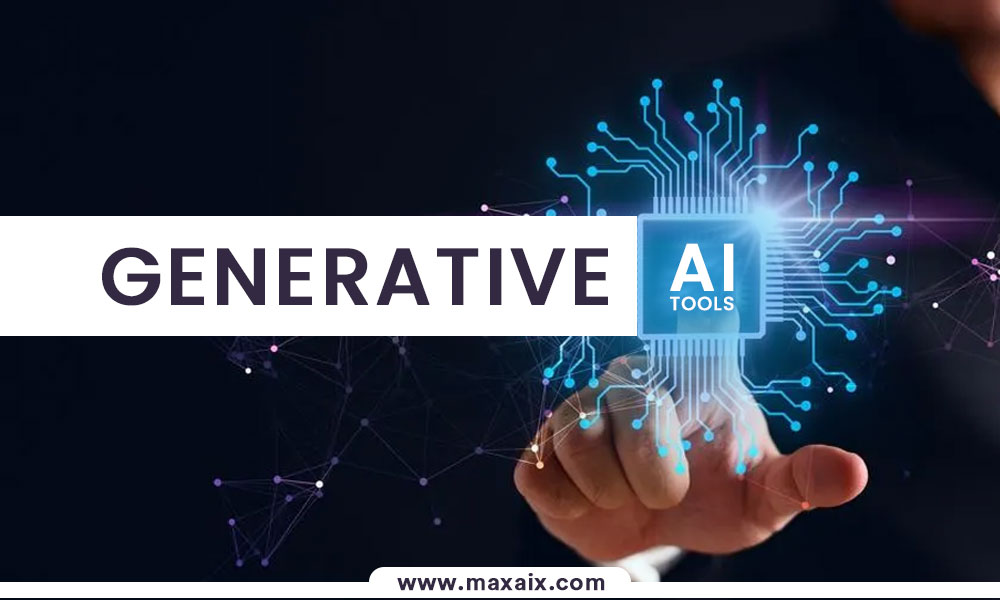7 Best Generative AI Tools and Platforms Categories for 2024

What is AI?
Artificial Intelligence (AI) is a branch of computer science that focuses on creating intelligent machines capable of performing tasks that typically require human intelligence. These tasks include learning, reasoning, problem-solving, perception, language understanding, and more.
What is Generative AI and Its Significance?
Generative AI refers to the use of algorithms and models that enable machines to generate content, data, or responses autonomously. Unlike traditional AI models that are trained on existing data, generative AI can create new and original content. Its significance lies in its ability to enhance creativity, automate content generation, and contribute to various industries.
The Growing Role of Generative AI Tools in Various Industries
Generative AI tools are playing an increasingly vital role across diverse industries:
Content Creation: In marketing, advertising, and media, generative AI tools are used to create engaging and personalized content.
Design and Creativity: Graphic designers and artists leverage generative AI to assist in creating unique designs and artistic pieces.
Programming: Generative AI can assist developers by suggesting code snippets, improving efficiency in software development.
Healthcare: In medical research, generative AI aids in drug discovery, medical imaging, and genomics.
Finance: Generative AI is employed for market analysis, risk assessment, and algorithmic trading strategies.
How Does the Generative AI Tool Work?
Generative AI works by utilizing neural networks and machine learning algorithms to analyze patterns and relationships within datasets. It learns from existing data to generate new content, make predictions, or complete specific tasks without explicit programming.
AI Applications
The applications of AI are vast and impactful:
- Natural Language Processing (NLP): AI is used for language translation, sentiment analysis, chatbots, and content summarization.
- Computer Vision: In industries like healthcare and autonomous vehicles, AI is employed for image recognition, object detection, and scene understanding.
- Speech Recognition: Virtual assistants and voice-activated devices utilize AI for understanding and responding to human speech.
- Recommendation Systems: AI powers recommendation engines in e-commerce, streaming services, and social media platforms.
What Are the Benefits of AI?
AI offers numerous benefits, including:
- Increased Efficiency: Automation of repetitive tasks leads to improved productivity.
- Data Analysis: AI can process and analyze large datasets quickly, extracting valuable insights.
- Personalization: AI enables personalized experiences in marketing, content, and user interactions.
- Problem Solving: AI algorithms can address complex problems and provide solutions in various domains.
Best AI Writing Software
AI writing software utilizes natural language processing algorithms to generate human-like content. Some top AI writing tools include:
- OpenAI’s GPT-3: Known for its language generation capabilities, GPT-3 can create coherent and contextually relevant text.
- ChatGPT: Developed by OpenAI, it is designed for conversational agents and can generate human-like responses in chat-based applications.
- ShortlyAI: This tool assists in generating blog posts, articles, and creative writing content.
- Writesonic: Suitable for marketing content, Writesonic helps in creating ad copies, product descriptions, and more.
Winning Examples of AI Used Today
Several industries are successfully implementing AI to achieve remarkable outcomes:
- Healthcare: AI aids in diagnosing diseases, personalizing treatment plans, and managing patient data efficiently.
- Finance: AI algorithms are used for fraud detection, risk assessment, and algorithmic trading in financial markets.
- E-commerce: Recommendation engines powered by AI enhance the shopping experience by suggesting relevant products.
- Manufacturing: AI-driven robotics and automation streamline manufacturing processes, improving efficiency and quality.
Top 7 Generative AI Tools and Platforms
In 2024, several generative AI tools and platforms stand out for their capabilities in different domains:
OpenAI
Key Features:
GPT-3-powered language generation.
Versatile applications in content creation, code generation, and more.
Benefits:
State-of-the-art language understanding.
Large-scale content generation.
Use Cases:
Writing assistance, chatbots, content creation.

Runway ML
Key Features:
User-friendly platform for artists and creators.
Supports multiple AI models for creative projects.
Benefits:
Empower creators with AI capabilities.
Democratizes AI for artists.
Use Cases:
Creative coding, generative art, interactive projects.

Chatbot.com
Key Features: Conversational AI platform for building chatbots.Drag-and-drop interface for easy bot creation.Benefits: Simplifies chatbot development.Supports multiple channels for deployment.Use Cases: Customer support, lead generation, conversational interfaces.

Replika
Key Features:
AI chatbot with conversational abilities
Emotional intelligence development
Continuous learning and adaptation
Benefits:
Personalized chatbot interactions
Emotional support and companionship
AI-driven conversational experiences
Use Cases:
Virtual companionship
Conversational AI for websites
Emotional intelligence training

Artbreeder
Key Features:
Online platform for collaborative art creation.
Uses generative algorithms for image manipulation.
Benefits:
Allows users to create unique artworks collaboratively.
Provides an intuitive interface for artistic expression.
Use Cases:
Collaborative art projects, image manipulation.

DALL-E
Key Features:
A generative model for creating images from textual descriptions.
Developed by OpenAI, an extension of the GPT-3 architecture.
Benefits:
Transforms textual input into visually coherent images.
Expands creative possibilities for visual content creation.
Use Cases:
Image synthesis, content creation, visual storytelling.

JukeBox
Key Features:
Music generation with lyrics
Customizable music styles
High-quality audio output
Benefits:
AI-driven music composition
Versatile music styles and genres
Integration with multimedia projects
Use Cases:
Original music composition
Soundtrack creation for videos
AI-assisted music production

How Can Businesses Use Generative AI Tools?
Businesses can leverage generative AI tools across various domains:
- Content Creation: Automatically generate engaging and SEO-friendly content for marketing purposes.
- Design and Creativity: Use AI tools to assist graphic designers and artists in creating unique designs.
- Programming: Enhance software development efficiency by utilizing AI-generated code snippets and suggestions.
- Healthcare: Apply generative AI in medical research for drug discovery and genomics.
- Finance: Use AI algorithms for market analysis, risk assessment, and algorithmic trading strategies.
AI Tools for Businesses
Businesses can benefit from a range of AI tools:
- Communication Tools: AI-powered chatbots and virtual assistants enhance customer interactions.
- Data Analysis Tools: AI-driven analytics tools provide valuable insights
- CRM Solutions: AI-enhanced Customer Relationship Management tools improve customer engagement and satisfaction.
- Marketing Automation: AI-driven marketing platforms optimize campaigns, personalize content, and improve lead generation.
- Supply Chain Management: AI applications optimize supply chain processes, reducing costs and enhancing efficiency.
- Human Resources: AI tools streamline HR processes, from recruitment to employee engagement and performance analysis.
No Code? No Problem. Here Are the Top No-Code AI Tools
No-code AI tools empower individuals without extensive coding knowledge to harness the power of AI:
Bubble:
Features: Visual development platform for web and mobile applications.
Benefits: No-code environment for creating AI-enhanced web applications.
Adalo:
Features: No-code platform for building mobile and web applications.
Benefits: Simplifies app development, including AI integrations.
OutSystems:
Features: Low-code development platform with AI capabilities.
Benefits: Speeds up application development, even for users with limited coding expertise.
Retool:
Features: No-code and low-code platforms for building internal tools.
Benefits: Enables users to create data-driven applications without extensive coding.
How IT Teams Use AI
Information Technology (IT) teams leverage AI for various purposes:
- Automated Monitoring: AI algorithms monitor system performance, detect anomalies, and predict potential issues.
- Cybersecurity: AI enhances security measures by identifying patterns indicative of cyber threats and providing real-time threat intelligence.
- Data Management: AI tools assist in data classification, storage optimization, and efficient data retrieval.
- Process Automation: IT processes benefit from AI-driven automation, reducing manual efforts and minimizing errors.
The Best AI Tools for Developers
Developers can utilize a variety of AI tools to enhance their workflows:
GitHub Copilot:
Features: AI-powered code completion tool developed by GitHub and OpenAI.
Benefits: Assists developers by suggesting whole lines of code, improving coding efficiency.
TensorFlow:
Features: Open-source machine learning library developed by Google.
Benefits: Supports the development of machine learning models, particularly in the field of deep learning.
Jupyter Notebooks:
Features: Interactive web application for creating and sharing documents with live code.
Benefits: Facilitates collaborative coding and data visualization.
PyTorch:
Features: Open-source machine learning library developed by Facebook.
Benefits: Widely used for deep learning applications and research.
AI and the Future of Work
The integration of AI in the workplace is transforming how we work:
- Increased Efficiency: Automation of routine tasks allows employees to focus on more complex and creative aspects of their roles.
- Data-Driven Decision Making: AI provides data analytics and insights, supporting informed decision-making processes.
- Enhanced Personalization: AI tools personalize user experiences, from customer interactions to employee training.
- Collaborative Robots (Cobots): AI-driven robots collaborate with human workers, improving productivity and safety.
Conclusion
Generative AI tools have become indispensable across various industries, revolutionizing creativity, efficiency, and problem-solving. From content creation and design to development and business operations, the applications of generative AI are vast and continually expanding. As we look forward to 2024, the role of AI in shaping the future of work and innovation is more evident than ever.
Frequently Asked Questions
Q1: What are some free generative AI tools?
Several generative AI tools offer free versions or trial periods, including OpenAI’s GPT-3 for text generation and RunwayML for creative projects.
Q2: How can I build an AI tool?
Building an AI tool involves understanding your use case, collecting relevant data, selecting appropriate algorithms, and using programming languages such as Python. Alternatively, you can explore no-code AI tools for a simpler approach.
Q3: How do generative AI tools benefit websites?
Generative AI tools enhance websites by providing dynamic and engaging content, creating unique visuals, and improving user interaction through chatbots.
Q4: Can generative AI tools be used for code generation?
Yes, generative AI tools like GitHub Copilot assist developers by suggesting context-aware code snippets, improving coding efficiency.
Q5: What is the significance of AI in the future of work?
AI is expected to play a significant role in the future of work by automating routine tasks, enhancing efficiency, and fostering innovation in various industries.
Q6: How do AI tools contribute to business growth?
AI tools contribute to business growth by improving decision-making, enhancing customer experiences, and providing innovative solutions for product development and marketing.
Q7: What are the key benefits of AI writing software?
AI writing software offers benefits such as time efficiency, improved content quality, and assistance in creating engaging and relevant written material for various purposes.
Q8: How can businesses use generative AI tools for customer interaction?
Generative AI tools can be used to build interactive chatbots that enhance customer interaction by providing instant responses, personalized recommendations, and efficient query resolution.
Q9: What are the different categories of generative AI tools?
Generative AI tools can be categorized into creative content generation, text generation, design and art, and code generation, each serving specific purposes across industries.


